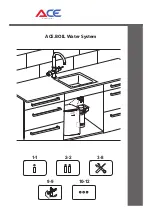
Installation Instructions
Residential Reverse Osmosis
Drinking Water System
Your Reverse Osmosis System has been tested to
ensure it will operate correctly.
The following
periodic maintenance is recommended so your
system will provide years of trouble-free service:
Replacement parts
Replacement
Pre-filters (sediment)
Every 6 mos.
Pre-filter (activated carbon)
Every 6 mos.
R/O membrane
Every 2-3 years
Post filter (carbon)
Every 6 mos.
Components
The following components make up your Reverse
Osmosis Drinking Water System:
Pre-filter
(sediment) removes larger particles such
as sand, silt, rust and scale.
Pre-filter
(activated carbon) removes chlorine in the
feed
water
to
protect
the
reverse
osmosis
membrane.
Reverse Osmosis Membrane
reduces
dissolved
minerals, metals and salts. During the process,
harmful
compounds
are
separated
by
the
membrane and the reject water goes to waste
(drain).
An activated carbon
post -filter
is provided for a
final “polish” and to remove foul tastes, odors and to
provide great tasting drinking water.
Filter housings
and
R/O module
hold pre-filters
and membranes.
A
bracket
is provided so they
may be mounted, typically below sink.
Storage tank
holds filtered water, ready for use.
Automatic
shut-off
valve
senses
when
the
storage tank is full and closes the water supply to
conserve water.
The dedicated
faucet
is used to dispense RO
produced water when needed.
Feed
water
saddle
valve
- we have replaced the
saddle valve with a John Guest angel stop valve.
See note below.
Waste water saddle valve
is connected to the
drain to remove reject water from the R/O system.
Tubing
supplies feed and reject water.
Fittings
are used for necessary hose connections.
Tools
The following tools may be necessary, depending
on each particular installation:
3/8” variable speed electric drill; 1/8” &1/2” bits
1-1/4” porcelain hole cutter (if hole for second
faucet is not provided).
Center punch and hammer
1-1/4” wood bit
Concrete drill bits
Phillips head and flat blade screwdrivers
Adjustable wrench
Crescent wrench
Teflon tape
Plastic tube cutter
Air pressure gauge (low pressure)
Air pump (hand)
System location
Your R/O system may be installed under a sink, in a
basement or other location, depending on available
space. Do not install unit where temperatures fall
below freezing; otherwise, damage will result.
Connection
to
an
icemaker
should
also
be
considered for optimum performance.
Guidelines for component placement are as follows:
Faucet
should be placed near the sink where
drinking / cooking water is normally required. A 2”
flat surface is required to mount the faucet if an
existing hole for a second faucet is not available.
The thickness of the mounting thickness should not
exceed 1-1/4”.
Storage tank
may be placed where it is convenient,
within ten feet of the faucet. Under the sink or in a
nearby cabinet are excellent choices.
If tank is
located further than ten feet from the faucet, use ½”
tubing to reduce pressure drop.
Full tanks may
weight more than thirty pounds, so a sturdy shelf is
required.
R/O unit
may be mounted on either side of the sink,
in a cabinet or heated basement, with nearby
access to a potable, cold water line.
Feed water connection
is accomplished with a
self-piercing feed water saddle valve. Locate this
assembly as close to the R/O unit as possible.
Connect to a potable, cold water supply line only.
Note:
Softened water is preferred since it will
extend the life of your R/O membrane.
Drain connection
is accomplished using a waste
water saddle valve which is designed to fit around a
standard 1-1/2” OD drain pipe.
The drain saddle
valve should always be installed above (before) the
tap and on the vertical or horizontal tailpiece.
























